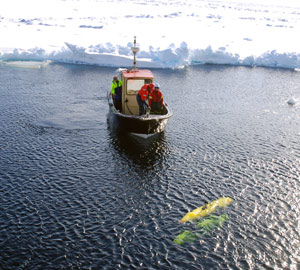Interview with Rob Reves-Sohn - Part II
by Lonny Lippsett

A test launch of Jaguar in June 2007. Photo by Daniel Torres, WHOI.
For one, the Arctic Ocean is semi-enclosed. The deep parts of the Arctic seafloor, where the vents would be, have been separated from the deep regions of the Pacific and Atlantic Oceans for about 26 million years. So whatever life there is at Gakkel Ridge vents has evolved over all that time in isolation from all other deep-sea life. They may have evolved novel adaptations to novel conditions on the Gakkel Ridge—much the way you find novel animals in Australia that you find nowhere else.
Why would conditions be different on the Gakkel Ridge?
We expect to find a type of rock on the Gakkel Ridge that’s very different from mid-ocean ridge rocks in other places on Earth. When plates are moving apart rapidly, you get lots of spectacular volcanic eruptions on the seafloor that produce a type of rock called basalt. But when you slow down the spreading process to where the two plates are kind of just barely opening apart, you get sporadic volcanism and not much basalt. Instead, you expose big slabs of material below the crust from a layer deeper called the mantle.
This material is called peridotite, and peridotite and basalt have very different chemical compositions. So when seawater chemically reacts with peridotite in a hydrothermal vent system, it generates hydrothermal fluids with a distinctive chemistry.
Why is that important?
Microbes convert the chemicals in vent fluids into energy, so if you have different chemistry, you’ll get different microbes at the base of the food chain and perhaps different animal communities around the vents.
The other interesting thing about peridotite-based hydrothermal systems is that they produce the kind of conditions that scientists think would have existed billions of years ago on Earth, when life was first emerging on our planet. So, who knows, we may see living “fossils” of animals that existed in primordial times.
Beyond the search for life, what else are you looking for?
Massive mineral deposits. When hydrothermal vent fluids react with the hot rocks beneath the seafloor, they form copper, zinc, and iron sulfides, and other minerals. We know that on mid-ocean ridges that are spreading apart slowly, hydrothermal fluids can circulate for a long, long time, to generate and build up massive mineral deposits on the seafloor. Since the Gakkel Ridge is the ultimate example of a slow-spreading ridge, there could be really large mineral deposits on the seafloor of the Gakkel Ridge.
But exploring all these fundamental questions—about the creation of our planet and life on it— ultimately seems to depend on being able to find hydrothermal vents in the first place, right?
Absolutely. The first thing we have to do is to determine if the evidence of so much hydrothermal activity that was found in 2001 is real. To do that, we have to actually find hydrothermal vents on the Gakkel Ridge. And to do that, we have to actually deploy and recover robotic vehicles through the ice to explore the deep ocean.
That is a difficult technological task. Nobody’s ever done that before, so we don’t have much experience. The truth of the matter is that sending vehicles off for a day or two under the ice is a terrifying experience. When those things sink down through the ice and go a couple of miles down—man! You’re just praying you get them back!
We have a rare opportunity to go to a place on our planet where measurements have never been made before, so we want to bring every piece of sensing and sampling equipment we possibly can because we don’t know if and when we’re going to get back there again. We’re trying to cross every “t” and dot every “i.” We’re trying the best we can, but obviously, there are no guarantees of success.
Page [ 1 ] [ 2 ]
[Back
to top]
| 
